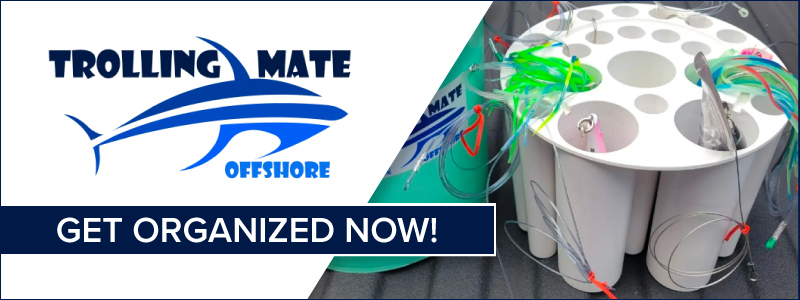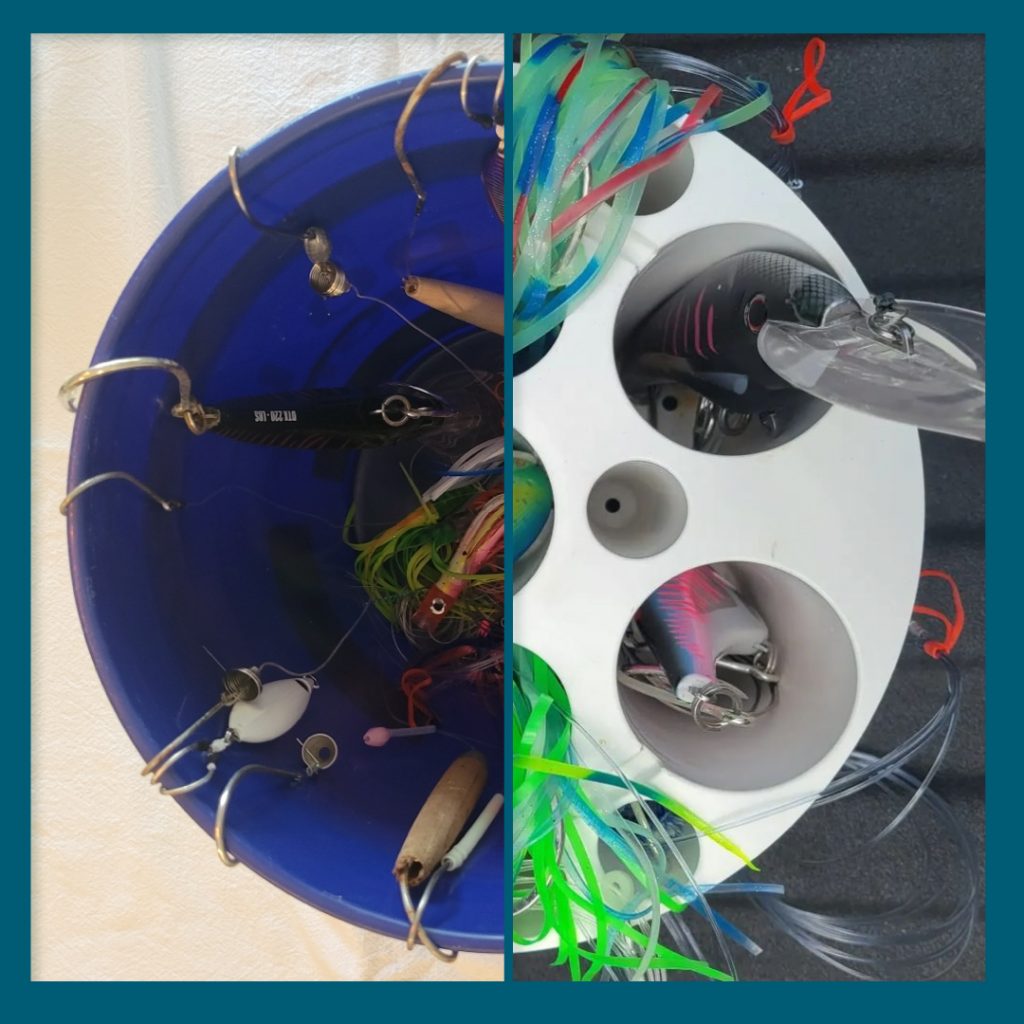How Trolling Mate Has Changed the Face of Fishing Tackle Organization
PartsVu Xchange Talks Boating spoke with Lance LeHew, co-founder of Trolling Mate.
After a successful career in the automotive collision and commercial real estate industries, Lance was able to sell his company and spend more time pursuing his passion for offshore fishing.
As he spent more time on the water, Lance realized that the lure management system many anglers use is fraught with frustration. We discuss fishing tackle organization and the types of problems Trolling Mate solves, the kinds of fishing Lance enjoys, and dig into some of his recent on-the-water adventures.
Want to listen to the podcast? You can find PartsVu Xchange Talks Boating on Apple Podcasts, Spotify, Amazon Music, iHeart Radio, and Stitcher.
Can you tell us more about some of the frustrations that led you to develop the Ready Bucket?
Lance: The Ready Bucket was born out of the need anglers have to deploy baits as rapidly as possible. When you’re out fishing and see that there are fish around, you want to be able to reach into your bucket and get your gear out as fast as you can—this requires effective fishing tackle organization.
Many anglers can relate to the mess a traditional bucket system causes regarding tackle and gear organization. We’ve all found ourselves ready to go, reaching into our buckets to pull out what we need. However, instead of getting one piece of tackle, we end up pulling up five or six because they’ve all become tangled together.
So, after many trips and discussing things with my co-founder Bill, we decided that there had to be a better way, eventually leading to the creation of the Ready Bucket.
Before the Ready Bucket, what other approaches did you try to use to solve the problem?
Lance: I feel like we tried at least ten different solutions. We tried everything from dry bags to zip-lock bags to pool noodles. None of those ideas panned out very well. Eventually, we landed on a PVC-style fishing tackle organization solution that worked out really well.
Can you describe how the product works?
Lance: It’s a plastic mold-injected item that weighs about five pounds. It’s made to slip into the bottom of any two or five-gallon bucket. We’ve tested it in a wide variety of buckets, and it fits in just about any bucket you can find.
What style of fishing is the configuration best suited for?
Lance: Our original thought was to make the bucket as universal as possible. However, our biggest markets are South Carolina, Florida, Louisiana, and Texas, so we designed our first Ready Bucket insert to fit the most popular lures in those regions.
The bucket has a thirty-millimeter hole, two holes that are fifty millimeters, and three holes that are ninety millimeters. That configuration allows us to put sea witches, islanders, and jigs into the smaller holes. The medium-sized holes are suitable for something like a stretch DT. Finally, the larger holes are good for DTXs, Mad Max, and larger lip lures. So, the bucket allows for a broad spectrum of lures typically utilized.
We have noticed that some anglers in the upper east coast were carrying mojos that don’t fit well into the current configuration, so our next generation will have an increased number of larger-sized holes to accommodate larger profile lures.
Do you think there will be a need for multiple bucket variations for different markets?
Lance: For now, we envision three different buckets that all serve the same purpose but are built for different-sized baits and lures.
How has the response been in the market for the product?
Lance: People usually buy one and then come back for more.
We went to ICAST, the White Marlin Open, and the Virginia Beach Tuna Tournament. When people walk up to our booth and see our display, they instantly relate to the problem we are solving.
We have two buckets on display during shows. One bucket is full of tackle and looks like most people’s tackle bucket, full of tangled lures and baits. On the other hand, our product looks vastly different. It’s a well-organized system that saves time so anglers can fish more efficiently with less hassle. The displays starkly contrast and resonate well with the fishing community.
Are most of your users charter captains on bigger boats, or are you selling to smaller boats too?
Lance: We’ve sold to a wide range of customers. For example, we have sold to people with eighteen-foot center consoles but also have buyers running trips on seventy-foot boats. Since we have so many variations of hole patterns, the product appeals to a broad spectrum of fishermen.
How does the bucket make cleaning more manageable at the end of a trip?
Lance: At the end of the day, I mix a little soap with water and fill the bucket to the brim. The next morning, I empty the bucket, remove the insert, and let it dry in the air and sun. The insert dries out well, so my terminal tackle rusts much less than before.
Saving and preserving baits is important when considering offshore lures’ costs. Sometimes, you’re spending upwards of sixty dollars on a lure, so anything that helps deter corrosion will save people money in the long run.
How many Ready Buckets do you usually see on a boat?
Lance: I carry three because I like to segment my baits. I keep my rubber-skirted baits in one, my fiber-skirted baits in another, and different colors in my third bucket. Each bucket holds twenty-four lures, so there is plenty of space to keep things tidy.
I think most anglers could make it happen using two buckets. However, one bucket holds plenty, which would suffice for many applications.

Can you tell us a little about your current boat, how long you’ve had it, and what engines you run on it?
Lance: I fish out of a Sea Fox 288 Commander with about eleven hundred hours, most of which are offshore. It takes us about sixty miles of running to reach our destination, so that’s about two hours; then we spend all day trolling, followed by a return trip of two hours.
I’m really excited about my newest purchase, a 47 Viking. It’s outfitted with a total of sixteen hundred horsepower, so it moves pretty well for a forty-seven-foot boat.
I’ve spent the first few weeks tweaking, adding, and making changes. We’ve also spent some time getting to know the boat and adjusting to the increased size, so we are comfortable maneuvering and docking. We’ll probably take an actual trip in the next couple of days.
Where are some of the places that you fish and boat in general?
Lance: We’re usually fifty to eighty miles offshore. We like to start at South Edisto Banks and work our way up to Royal Terrace, one of our favorite places. After that, we usually move a little further north to the ledge, and then we usually get a little close to the Myrtle Beach area or the southwest banks.
I’m looking forward to possibly expanding those areas with the new Viking to push out further.
If you’re looking for a fantastic fishing tackle organization solution, check out Trolling Mate’s Ready Bucket. These buckets are a clever way to segment your tackle to make things more easily accessible so you can spend more time fishing and less time trying to find and untangle lures. They also make end-of-the-day cleaning less of a hassle.
The post How Trolling Mate Has Changed the Face of Fishing Tackle Organization appeared first on PartsVu Xchange.

